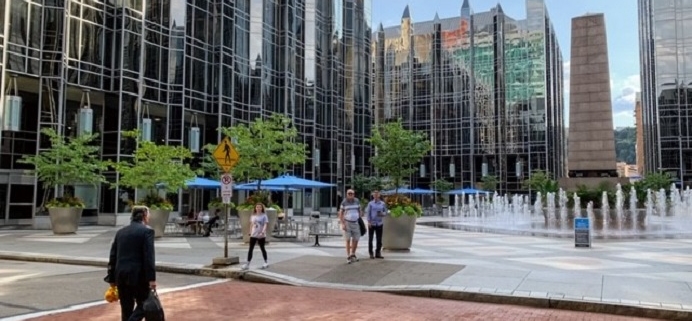Pittsburgh Buildings, Bridges, and Cable Cars
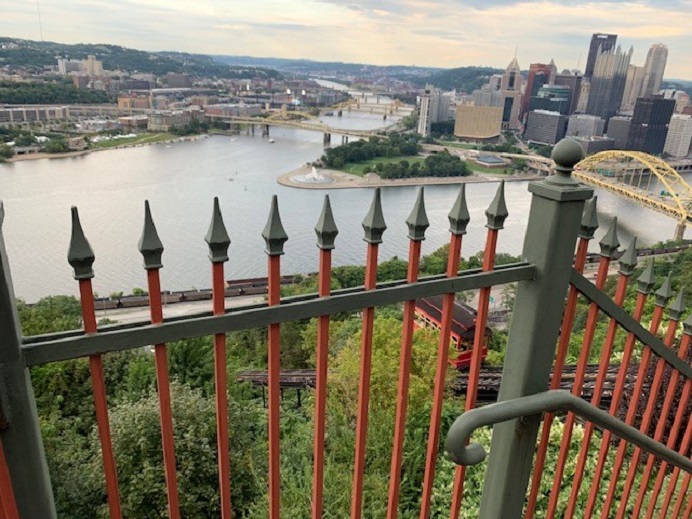
Pittsburgh’s “Golden Triangle” officially the Central Business District
On a recent visit to Pennsylvania, we enjoyed discovering Pittsburgh buildings, bridges and cable cars.
Pittsburgh is a city of over 300,000 people located in beautiful southwestern Pennsylvania. It was established in 1758 by General John Forbes and named in honor of British statesman William Pitt. Known as “Steel City” and the “Gateway to the West”, Pittsburgh was attractive to development because of its proximity to waterways and natural resources. Like the structures in similar cities, many older Pittsburgh buildings were destroyed by a fire in 1845. Today, Pittsburgh is a modern hub of education, medicine, and research.
When we drove into Pittsburgh, we couldn’t help but notice the lovely rivers and bridges. The Allegheny and Monongahela Rivers come together at the tip of the downtown “Golden Triangle” to form the Ohio River. 446 bridges connect the city, which is made up of 90 neighborhoods.
The city of rivers and bridges is also a city of beautiful architecture and friendly people.
We enjoyed taking a self-guided downtown architecture walk and discovered some neat gems, like the handsome men’s wear store Heinz Healey’s Gentlemen’s Apparel at 160 Fifth Avenue. Learn more about the efforts to revitalize downtown’s historic structures here.

Bob Bleck and his favorite travel companion Patricia Bleck.
Prominent Pittsburgh Buildings
It’s hard to choose from the many buildings we visited on our recent trip. From historic fort structures to office buildings and stadiums, Pittsburgh buildings are well worth a visit. Here are just a few of our favorites:
Fort Pitt Blockhouse a stone, brick, and timber structure, was built in 1764 as a defensive redoubt for Fort Pitt. The National Historic Landmark is owned by the Fort Pitt Society of the DAR and it is the oldest building in Pittsburgh. It is located in Point State Park and is open to the public.
Sporting News magazine named Pittsburgh the “Best Sports City”. All stadiums for local pro sports teams are conveniently located within a few minutes of downtown: Steelers (NFL) at Heinz Field by architect HOK Sports, Pirates (MLB) at PNC Park by architect HOK/LDA, Penguins (NHL) PPG Paints Arena by architect Louis Astorino.
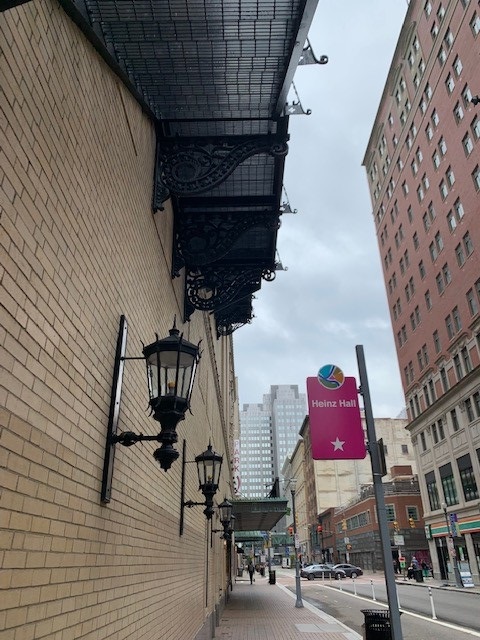
Architectural details of Heinz Hall
Pittsburgh is home to Carnegie-Mellon University and the University of Pittsburgh. Architect Charles Klauder designed Pitt’s Cathedral of Learning (1931), the centerpiece of the campus. It is listed on the National Register of Historic Places. You can tour The Nationality Rooms, a collection of 31 classrooms on the first and third floors, to experience the ethnic identity of the various groups that settled in the area and who helped to build the city.
Heinz Hall for the Performing Arts is home to the Pittsburgh Symphony Orchestra. Designed by Rapp & Rapp architects as an opulent movie theater, the structure was completed in 1927 and closed as a theater in 1964. It reopened in 1971 as the home of the symphony after a 3-year reconstruction project.
PPG Industries, the first commercial plate glass manufacturer, produced high-quality thick flat glass using the plate process. Philip Johnson and John Burgee designed PPG Place, a complex of distinctive, post-modern buildings clad in reflective glass. They are located on a prominent three-block site in downtown Pittsburgh.
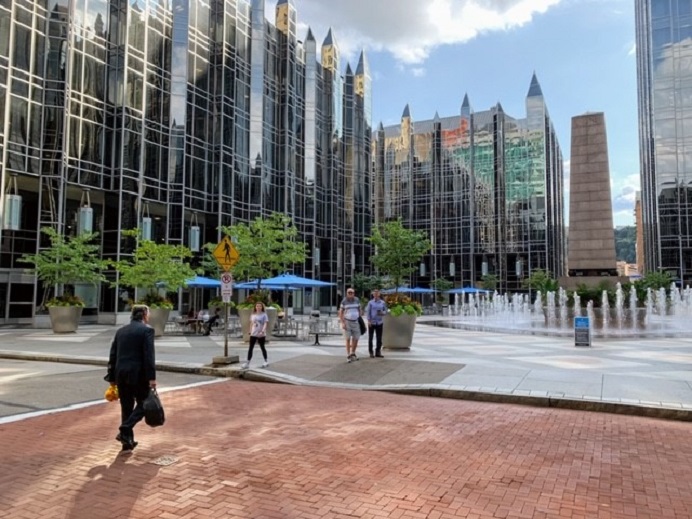
PPG Place, a complex of distinctive, post-modern buildings clad in reflective glass.
Andy Warhol Museum is the largest museum in the US dedicated to a single artist. Celebrating its 25th anniversary in 2019, the museum is housed in a former industrial warehouse and distribution center repurposed by architect Richard Gluckman. We really enjoyed seeing how the architect adapted an industrial building for the display and interpretation of the artist’s life and work.
The first all-aluminum clad building, the ALCOA (The Aluminum Company of America) Building, was designed by Harrison & Abramovitz and completed in 1953. The innovative radiant mechanical system in the ceiling allowed for more rentable space. Standing 30-stories and 410-feet tall, the skyscraper is now called Regional Enterprise Tower.
Senator John Heinz History Center is Pittsburgh’s history museum and is an affiliate of the Smithsonian. Architect Bohlin Cywinski Jackson adapted the Chautauqua Lake Ice Company building for use as a museum and oversaw the construction.
Fun Fact: Are you a fan of Mister Roger’s Neighborhood? You can see original set pieces and artifacts from the popular children’s show in the Special Collections Gallery.
An hour and a half south of Pittsburgh, you can visit Frank Lloyd Wright’s famous Fallingwater, a house that is cantilevered over a waterfall. Designed in 1935 as a weekend home for the Kaufmann family of Pittsburgh, it was completed in 1937. The Western Pennsylvania Conservancy owns and operates Fallingwater, which is open for tours and was recently named a UNESCO World Heritage Site.
Bridges and Cable Cars
You can’t talk about Pittsburgh without mentioning its bridges. In fact, the “City of Bridges” boasts more bridges than any other city in the world! The three rivers and many bridges that connect the parts of the city are very distinctive and well-loved. We learned that Pittsburgh is the home of the first cable suspension bridge (Monongahela Bridge), which used wire cable developed by John Roebling in 1840.
The city’s 446 bridges come in a variety of types, including suspension, arch and cantilever bridges. We noticed they are all painted Aztec gold and learned that gold and black are the colors of the city flag.

Pittsburgh’s 446 bridges come in a variety of types, including suspension, arch and cantilever bridges. We noticed they are all painted Aztec gold.
Did You Know? The very first Ferris wheel was built in Pittsburgh, by the Bethlehem Iron Company. It was later erected in Chicago at the grounds of the 1893 World’s Columbian Exposition.
One of our favorite things to do in Pittsburgh was to ride on the old inclined railways. The inclines were originally built to hoist coal and freight and to ferry passengers to the top of Mount Washington. A system of cables and pulleys, powered by engines at the top of the hill, raises and lowers red wood cars on rails. Today, the upper stations and observation decks are both handicapped accessible. The price to ride is very affordable ($2.50 one way and free for seniors) and the view of Pittsburgh is amazing!
Wow! Only two of the original 23 inclines are still in operation. The Monongahela Incline is the nation’s oldest and the world’s steepest at 35 degrees.
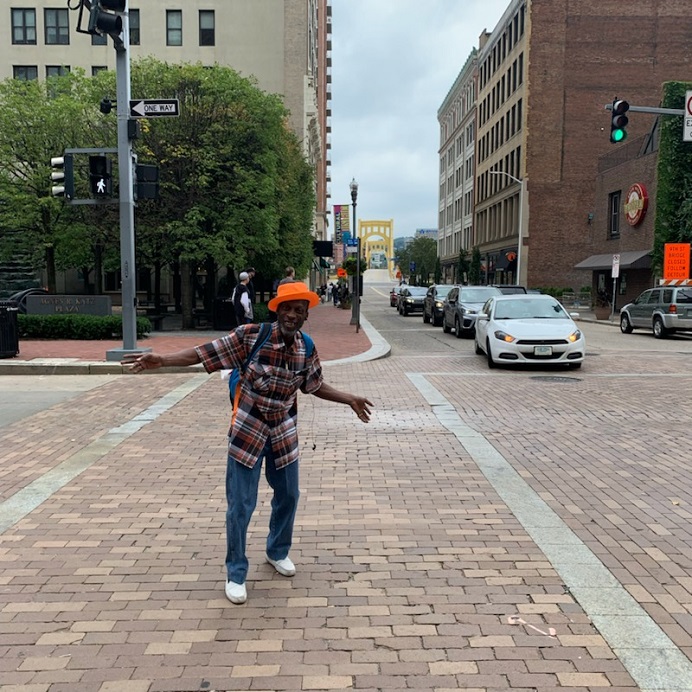
Look closely and you will see one of Pittsburgh’s Aztec-gold bridges. Easily spotted is one friendly local who really wanted to be in the picture.
Visit Pittsburgh to see the wonderful architecture, bridges, cable cars and friendly people!

